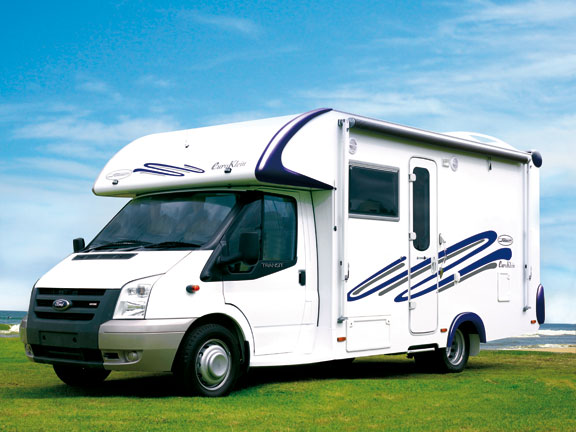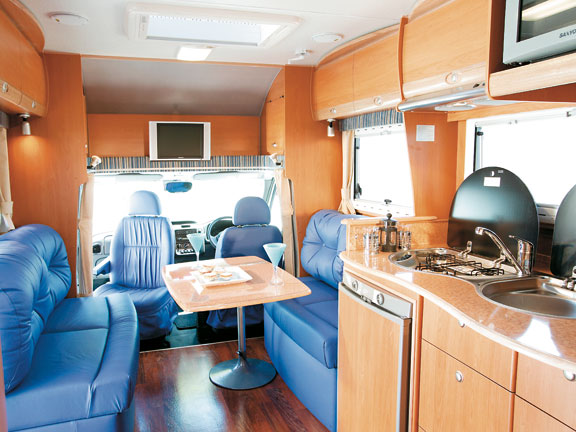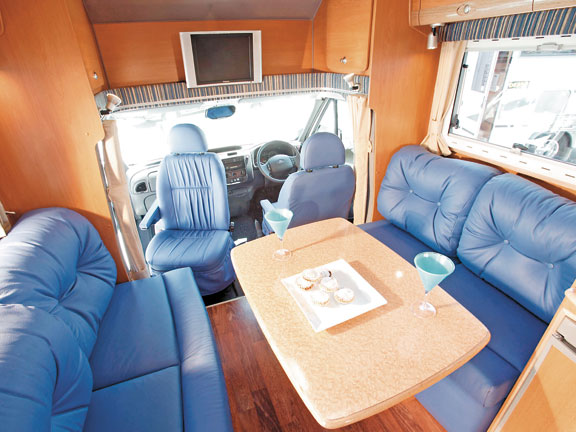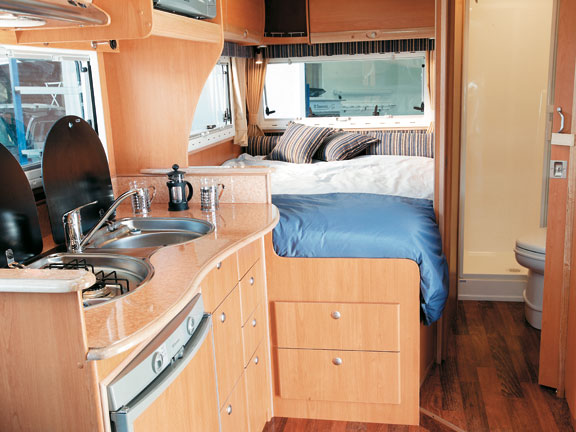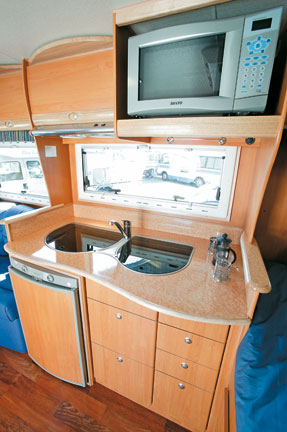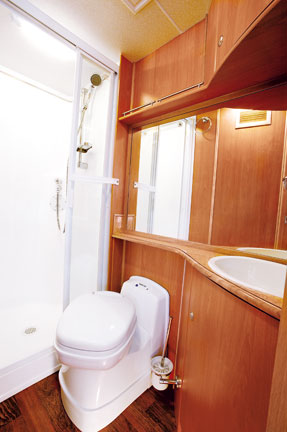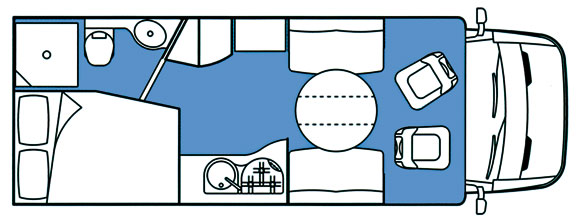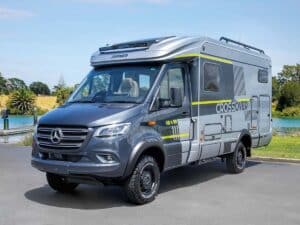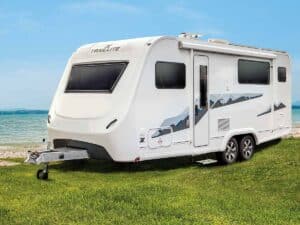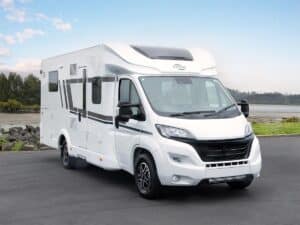Bill and I first stepped inside the Australian-built EuroKlein motorhome, one of Sunliner’s Euro range, when it made its debut into the New Zealand market at the Hamilton Motorhome show in 2007. We were impressed and sought it out at the Melbourne Caravan show a month later to have a more- comprehensive look.
Outside story
There’s no escaping the fact that the motorhome’s shape is box-like. The first thing Bill noticed was how the coloured fibreglass trim around the wheel arches, bumpers and peak and the swirling decal cleverly complemented and softened its lines.
It would be wrong to call the exterior shape sleek, but I liked its overall classy look – from its low-profile, sloping overcab right down to its stainless steel wheel trims.
The model we looked at was built on a Ford Transit chassis but it can also be built on a Mercedes Benz, Iveco, Renault, Isuzu and Fiat.
Unfortunately, because we have only seen it in motorhome shows, we were unable to test drive the EuroKlein and are unable to comment on its road manners. But on looks alone it gave a business-like impression, as if it couldn’t wait to be off and might show other motorhomes a clean pair of heels.
Inside look
When I stepped inside, I was keen to be off as there was no lack of comfort and the aesthetics were appealing. Sumptuously-padded, blue leather seating in the front end lounge, biscuit-coloured timber joinery with hardwood trim and moroon-coloured, laminated swivel table and bench top are a bold combination. The interior decor of the motorhome makes a striking statement and, at the same time, it is warm and inviting.
This effect is helped by the way the windows have been dressed with pelmets and curtains made of the same material. These are mainly homely touches because the window coverings also include two-way blinds and netting.
Bill was intrigued with the way the peak has been cut out so that the cab space is integrated with the lounge. This also means there is easy access from living space to the cab area. The passenger’s seat swivels so that the lounge can comfortably seat five people. This is an unusual feature in a vehicle that is only 23-feet long.
The steering wheel and dash can be curtained off and the TV/DVD comes down from at attachment at the joining edge of the peak so that it can be watched comfortably and up-close from the lounge seating.
Living space
One of the hallmarks of the van is the way the layout and decor have achieved a feeling of spaciousness in a smaller vehicle. It’s exterior shape means there is plenty of inside headroom and clever visual effects add to this, mainly the ceiling made of light-coloured, textured formica.
The cupboards are decent rather than dinky – generous kitchen cupboards and sliding drawers set back under the lip of the bench, deep stashing cupboards over the bed and a curve-shaped, double-door, full-length wardrobe with hanging space on one side and roomy shelves on the other.
The wide kitchen bench is curved to add extra depth to its surface and because both the inset hobs and the sink are lidded, there is good space for food preparation (although for me, there is never enough).
Adding to the illusion of (rather than the actual) space are the two large, single, Dometic, awning windows on either site of the dining area and the large hatch above.
The bathroom is surprisingly spacious with a great ambience. There is a generous separate shower, a swivel toilet, plenty of good storage space for washing and beautifying preparations, towel rail, soap holders mirrors, good lighting and a vent. Best of all, perhaps, is a corner basin that I could actually bend over properly without hitting my head.
The compromise in this generally spacey and airy layout is the bed, which is set permanently between the bathroom and outside walls. It’s a queen-size but can only be accessed from the foot of the bed, which is disturbing if you or your partner get up a lot in the night, and is not the easiest to make.
Bill liked the fluro lighting in both the home and the bathroom and the practicality of the spotlights for the swivel front seats, over the step and in the front lockers.
He also noted the air-conditioner in the saloon, and the security/fly screens on door that can be used separately. He also remarked that the electrics and plumbing placements had been well thought out and that the boot storage, batteries and gas bottle hatches were easily accessible from outside.
Kiwi connection
Sunliner is a family-run business which, after a fashion, had its origins in New Zealand. Sue and Tony Hunter moved from Tauranga to Melbourne in 1974, where Tony worked as a mechanic. For his and Sue’s own use, he decided to fit-out a VW-kombi so they could tour through their adopted country. He then fitted out another, followed by another and when he decided to extend the skill to other vehicle makes, he moved from his backyard to a small factory and went into business.
It was not until the early-eighties that he started building motorhomes. Today, although he is still the strongest influence in the enterprise, the general manager is his son, Nic and the marketing manager is Melissa, his daughter. The Sunliner company produces five series of mid-to-high-end motorhomes, each with several models, a total of around 250 vehicles per year.
“Sunliner has a vested interest in bringing our products to New Zealand,” said Melissa. “We are doing it for personal reasons as well as commercial. The thing is, it has always been Tony’s dream to be in the New Zealand market. He moved to Melbourne from New Zealand, made something of himself and a product he is proud of, and now he wants to bring that success back ‘home’.” I am sure he will be welcome.
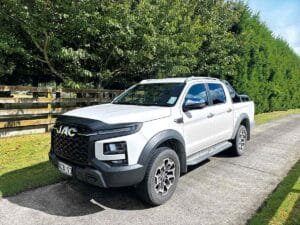
Review: JAC T9
For those passionate about adventuring with their caravan, one of the most important keys to success is a competent tow vehicle. We take a look at a newcomer to the market – the JAC T9.

